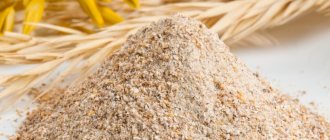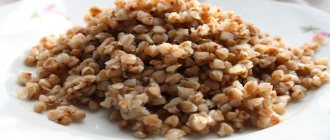Properties of adjika
Nutritional value and composition | Vitamins | Minerals
How much does adjika cost (average price for 1 jar)?
Moscow and Moscow region.
48 rub.
It is difficult to imagine Georgian cuisine without adjika, which is a seasoning consisting of many savory ingredients, in particular spices and herbs. Initially, it appeared in the Caucasus, where it became very popular, after which adjika began to be used with pleasure in the national cuisines of different countries.
Adjika, which can be either in the form of a paste or in a powdered state, is capable of giving numerous dishes a special aroma and taste: subtle, pungent and bittersweet. The color of this seasoning directly depends on the composition of adjika: it is characterized by red, brown, orange or green. The calorie content of adjika in the form of sauce is just over 59 kcal.
The Caucasus is a broad concept that includes more than one country, so the culinary homeland of adjika is considered to be Abkhazia, where the very name of this seasoning means a very common product - salt. Abkhazians call adjika pepper salt or salt that has been ground with something - it all depends on the composition of the seasoning.
According to ancient legend, adjika was invented by Abkhazian shepherds who herded sheep in the mountains. The owners of the animals gave the shepherds salt with them in order to add it to the food of the sheep. The animals were full of salt and very thirsty, but they were not given water. Then the sheep had to eat grass in large quantities to quench their thirst, as a result of which they very quickly gained weight - this is what the owners wanted.
Probably, salt in those days was quite expensive, so it was saved, and shepherds were forbidden to add salt to their food. To avoid breaking the taboo, sheep owners diluted the salt with red pepper and spices in the hope that the shepherds would not like such a mixture. But in vain - the shepherds appreciated the taste of salt and spices and began adding other ingredients to it, subsequently calling this mixture adjika.
Application
Adjika is used as a seasoning in the preparation of various marinades, sauces, stews and soups. Adjika is added to dishes made from meat, chicken, rice, eggs and beans. Adjika goes well with vegetable stew, eggplant or squash caviar.
Adjika is a fairly universal seasoning and can be suitable for various dishes. In Abkhazia, almost everything is eaten with adjika. Cottage cheese and pickled cheeses are seasoned with green adjika. Red adjika is used in the preparation of nut dough, and the oil pressed from it is used to season dishes. The seasoning is also eaten by spreading it on bread, flatbread or pita bread.
Market Analytics
- COVID-19 is changing the rules of the game in the cosmetics market
- Beauty of the future: cosmetic innovations 2020
- New ingredients are the driving force of the cosmetics industry
Convenient search for beauty salons on our website
Beauty salons in Moscow Beauty salons in St. Petersburg Beauty salons in Ekaterinburg Beauty salons in Novosibirsk
Latest blog posts on our website
- Naturecream / Geranium (Pelargonium) oil for skin health and beauty
- Prostye-sovety / Save on a beauty salon: procedures that can be done at home
- Naturecream / Growth Factor - brings back youth?
- Oksana-Lezina / 3 effective abdominal exercises from a fitness instructor for beginners
- Prostye-sovety / Making perfect curls at home
- Prostye-sovety / Which hair removal method to choose
- Naturecream / Wrinkles Puppets
- Naturecream / PEPHA-TIGHT - instant skin lifting
- Naturecream / Blue light - a danger to the skin
- Naturecream / Cocoa Butter – A treat for the skin
Latest forum topics on our website
- Mrs._Smith / Badly sunburned! What to do?((
- Ice / Is it necessary to combine fitness classes with a diet?
- Antonova / What can be used for hair loss?
- Radio operatorKat / Who was on a protein diet?
- Suzanna / Mesotherapy on the face
Other articles in this section
| Mayonnaise Provence Mayonnaise was first prepared in France, in a city called Mayon - hence the name of modern mayonnaise. The date of production of the first mayonnaise according to the classic recipe dates back to the 18th century. The ancestor of mayonnaise was a sauce that was prepared in Spain from eggs, olive oil and garlic. |
| Vanillin For the vast majority of people, vanillin is a crystalline powder with a specific rich vanilla aroma. The demand for vanilla is much higher than the possibility of obtaining a natural product. Therefore, people had to use chemical reactions to reproduce artificial vanillin to satisfy all the needs. |
| Sea salt Modern scientific research has proven that it was in the sea water of the World Ocean that life first originated. It turns out that the composition of the blood of many animals is very similar to the composition of sea water. This allows us to conclude that sea salt is a symbol of life and health. |
| Fresh basil Basil is known to many as a culinary seasoning. Possessing a special aroma, this spice has found reverence in the cuisines of Central Asian countries, as well as in Western Europe. There are a large number of varieties of this plant, each of which has its own subtle aroma - from rich clove to light peppery aroma. |
| Ginger Ginger is an exotic perennial plant native to tropical and subtropical climates. The countries of Southeast Asia are considered to be its historical homeland. Currently, industrial plantations of cultivated ginger are located in China, India, Indonesia, Australia and some West African countries. A rare type of ginger is grown in Jamaica, which has a unique delicate aroma. |
| Cardamom This spicy seasoning has been known since ancient times. Cardamom was credited with healing properties. It was believed that it could relieve migraines, colds, and cure liver and intestinal diseases. Greek winemakers could not imagine drinks without cardamom grains. In the Middle Ages, the fruits began to be used for salting meat and fish. Until now, it is popular all over the world and in terms of sales - it ranks second after black pepper. |
| Honey Honey is a natural product with unique properties. The appearance is thick, it is characterized by a viscous mass with pronounced taste and aroma qualities. The sweetness of honey is much higher than that of sugar and at the same time it is more velvety. The color of honey depends on which inflorescences the bees collected it from and the period of collection. The lighter the honey, the lower the concentration of minerals and trace elements. |
| Zira Zira - seeds of the herb cumin, which belongs to the parsley family, is sold in the form of oblong-shaped grains. In many countries it is usually called by its Latin name; in our country it is called the same as in the East. This seasoning has been known since ancient times, but has gained great popularity in oriental cuisine for medicine. The history of the use of cumin goes back many centuries. It is often confused with caraway seeds, which are similar in appearance to cumin grains. Due to its specific taste, it is often used as a seasoning for bread and meat dishes. |
| Raw sugar Raw sugar is a unique, incompletely processed, easily digestible food product. It tastes sweet, most often of cane origin, less often made from sugar beets, as it has an unpleasant aftertaste and lower content of microelements. Available in light brown, gray and white colors. |
| Saffron The spice that can be called the most expensive in the world is saffron. For its production, exclusively the stigmas of crocus flowers are used, which are crushed for this purpose. |
The benefits of adjika
What is surprising: such a fiery-spicy seasoning as adjika can prevent the occurrence of many gastrointestinal diseases, including stomach ulcers. In addition, the benefits of adjika include improving metabolism, normalizing digestion and functioning of the circulatory system.
For frequent colds, the benefits of adjika are also observed, since the substances in this aromatic seasoning strengthen the body's defenses and kill harmful viruses. Just look at the chemical composition of this product and it immediately becomes clear that adjika is a rather valuable dish for human health.
This seasoning is contraindicated exclusively in the case of chronic and acute gastritis, as well as exacerbations of kidney and liver diseases. Adjika should also not be used by children and women during pregnancy.
Homemade adjika
Adjika made from bell pepper is aromatic and not at all bitter. It is perfect for homemade meat, delicious vegetables and first hot dishes. The nutritional value of this supplement is characterized by 68 kcal per 100 grams and a minimum content of fats and carbohydrates - 3.3 grams. and 8.7 g. respectively. The ingredients are designed for 100 servings and are almost always available at home. To produce it we will need:
- 1 kg bell pepper;
- 2.5 kg tomato;
- 1 kg carrots;
- 1 kg apples;
- 1 tbsp. Sahara;
- 1 tbsp. oils;
- 200 gr. garlic;
- 1 tbsp. vinegar;
- ¼ tbsp. salt.
To complete the recipe, just follow a few simple steps:
- rinse all vegetables thoroughly with drinking water, remove defects and bruises, if any, and pass through a meat grinder;
- then place in a container intended for the oven and cook for 1 hour over low heat, stirring occasionally so that the mixture does not burn;
- at this time, finely chop the garlic;
- after the time has passed, all other additives and spices must be added to the composition and boil for another 10 minutes;
- Sterilize the jars, spread red pepper adjika over them, roll them up and cover with a warm jacket or blanket until they cool completely. Bon appetit!
Many housewives do not accept apples as part of a classic Georgian dish and believe that it is bitterness and spiciness that give that unique taste of the seasoning to which we have become accustomed since childhood.
Spicy adjika
For all lovers of fiery seasonings, spicy dishes and bitter additions to poultry and meat, this cooking option will be the best. The calorie content of adjika is 59 kcal per 100 g. finished product. Protein content - 1 g, fat - 3.7 g, carbohydrates - 5.8 g.
And so, take:
- 500 gr. hot chili pepper pods;
- 1 PC. carrots;
- 300 gr. Sahara;
- 1 tbsp. l. salt;
- 0.5 tsp vinegar;
- 2 cloves of garlic;
- 700 ml of drinking water;
- 80 ml oil;
- 250 gr. tomato paste;
Prepare protective gloves so that hot pepper secretions do not damage the delicate skin of your hands and further:
- cut it into strips, simultaneously removing the stems and seeds;
- scald the prepared pieces at least twice with boiling water;
- grate the carrots as you would for a Korean salad;
- In a separate container, combine water, tomato paste, salt and sugar. Mix thoroughly;
- put on fire, pour in sunflower oil and bring the mixture to a boil;
- put peppers and carrots into the boiling mixture, cook for half an hour and at the end add finely chopped garlic and vinegar.
- After a few minutes, remove from the burner and place the adjika into the jars.
To make your bitter sauces fragrant and aromatic, do not forget to generously saturate them with spices and herbs to taste. Add dill - its universal taste will never spoil the end result. If you prefer adjika with meat, add more basil. Its light smoky flavor goes well with the rest of the ingredients. For lovers of oriental cuisine, culinary experts recommend adding cilantro to adjika.
Cooked with tomatoes or chili peppers, fresh or boiled, rolled up or simply covered with a nylon lid, sent to the refrigerator for storage - bitter, aromatic adjika made from bell peppers always contains few calories, it is tasty and is suitable as a seasoning for any dish. No matter how much you cook, it will all go away in an instant, as an addition to various homemade treats. Bon appetit!
How useful is information about the composition of a product?
What are the differences between the nutritional value of products and the energy component? Very often, for some people, both of these concepts intersect and even combine. The content of 3 components in 100 grams of product: proteins, fats and carbohydrates is called nutritional value. Energy value refers to the amount of energy released from eaten foods into your body during digestion. The calorie content of food products determines how much energy our body receives when it finally assimilates the product. The amount of energy directly depends on several factors, but the most significant of them is the composition of a particular food product.
The unit of measurement for the energy component is kJ. Another measurement unit that can be used is Kcal. Counting is done only per 100 grams. specific product. In order to determine the calorie content of foods, food calories are counted. The word "calorie" means something warm in Latin. A 1-calorie contains the amount of heat required to heat a gram of water by 1 unit. It is interesting that nutritionists in different parts of the world have slightly different information about the calorie content of the same foods. This is due to the growing conditions of the crops, and the difference in weather is the second reason.
All products contain kilocalories, but in certain products, for example, dried dill, light cola, there is a small amount of them. Plain water is considered a unique product with no calories. Information about the composition of polypeptide, lipid and saccharides in a particular dish, as well as data on the calorie component, is very easy to find in specialized collections of nutritional information about foods.
All three elements mentioned contain kilocalories. With the help of polypeptides, metabolism and energy transformations are regulated. Lipids have an energy component, and it is about 2 times more than carbohydrates. This component is broken down in the human body to glycerol, which produces energy.
What are we used to seeing in homemade adjika? The main components are, of course, hot peppers, garlic, tomatoes, salt, spices and herbs. As an addition, apples, zucchini, eggplants, sweet peppers, etc. are added to it. And all these additions are intended to soften the taste of adjika. Also, the calorie content of this seasoning depends on the composition of the ingredients from which it is made.
To begin with, before discussing specifically the question “,” let’s look at an example of one recipe for homemade adjika. It is prepared from the following ingredients: 1. 0.3 kg of tomatoes (but in general their quantity depends on the desired spiciness of the dish), 2. 1 tsp. table salt, 3. 1.5 kg sweet pepper, 4. 1 tbsp. sugar, 5. 0.35 kg garlic or onion, 6. 120 ml sunflower oil, 7. 5-6 hot peppers. Tomatoes, sweet and bitter peppers are washed, peeled as necessary and turned through a meat grinder into a homogeneous mass. Afterwards, the resulting vegetable puree is mixed with sunflower oil, salt and sugar. Raw adjika is cooked for about 2-2.5 hours until the mass thickens. Garlic, pressed in a garlic press, is added 30 minutes before the end of cooking. The finished adjika is transferred to sterilized jars and rolled up. The seasoning is stored in a cool place.
As you can see, adjika contains only vegetables. Therefore, “” can be considered average and even low. This is due to the fact that vegetables contain a small amount of protein and do not contribute to muscle building. This dish can even be included in a weight loss diet.
What are the benefits of homemade adjika? It is indicated for obese people with a lack of vitamins, carbohydrates and microelements. Carrots, which are also often included in adjika, contain keratin, an important element for normalizing visual function. Fresh garlic helps reduce high blood pressure, cholesterol levels, prevents blood clots in blood vessels, and improves immunity. Sweet pepper is rich in vitamins B and PP, potassium, phosphorus, sodium, iodine and iron; it is useful for anemia, diabetes, diseases of the nervous system and depression. contains fiber and minerals. Hot peppers enhance gastric secretion and promote food utilization. Apples are rich in iron; therefore they are useful for anemia and have choleretic properties. Of course, in case of exacerbations of the gastrointestinal tract, pancreas and liver, adjika is contraindicated for use.
Adjika contains a complex of useful substances from microelements, vitamins and carbohydrates. Even children over 10 years old can eat adjika in moderation.
Well, if we specifically touch on “” each product included in adjika, we get the following ratio (calories are indicated per 100 g of product): - tomatoes - 23, - apples - 50-60 (depending on the variety), - sweet peppers - 27 -30, - carrots - 30-35, - garlic - 140-150, - hot pepper - 40, - vinegar (wine, apple balsamic) - 9-14.
Adjika is a Caucasian seasoning with a fiery taste. This is why she is loved by many consumers. However, when using it as food, not everyone thinks about whether this product can cause harm to the body. It is this question that we want to address today. We will tell you what composition adjika has, the benefits and harms of the seasoning will be discussed in full. We will also give you a recipe for making this sauce.
Adjika recipes
Adjika, the benefits and harms of which were discussed above, has several recipes for its preparation. We will give you the most popular ones.
Classic recipe
- Hot chili pepper - 1 kg.
- Garlic - 500 gr.
- Khmeli-suneli - 3 tablespoons.
- Ground coriander - 3 tablespoons.
- Dried chopped dill - 3 tablespoons.
- Parsley - optional.
- Dill - optional.
- Cilantro - optional.
- Fine salt - ¾ cup.
Please note that it is better to prepare the product while wearing rubber gloves, as hot spices coming into contact with the skin can cause irritation.
Before preparing adjika, ground pepper should be slightly dried. To do this, place it on newspaper for several days or hang it in the sun, if possible.
Mix suneli hops, ground coriander and dried dill. You should have half a glass. If the product yield is larger, then the seasonings need to be subtracted, and if it is less, then add a little of everything. Grind pepper, garlic and selected herbs in a meat grinder or blender. After this, mix it with spices and salt. Place the resulting adjika in a glass jar with a lid and place it in the refrigerator. It is recommended to use it with meat dishes.
Recipe for adjika with tomatoes
Take:
- Tomatoes - 3 kg.
- Garlic - 500 gr.
- Hot chili pepper - 150 gr.
- Fine salt - 100 gr.
- Sugar - 3 tablespoons.
Grind the tomatoes, peeled garlic and chili peppers through a meat grinder or grind in a blender. After this, add salt and sugar to them. Place the resulting seasoning in small glass jars with lids. Adjika should be stored in the refrigerator.
Adjika, the benefits and harms of the sauce have been fully studied, is a tasty, but very spicy seasoning. To soften the taste, you can cook it with tomatoes according to the recipe that you will find in our article. However, even this option has all the contraindications mentioned above. That is why you will need to consult a specialist before using it.
Can adjika cause harm?
Despite the wide range of positive properties, adjika is not indicated for everyone. If this is not taken into account, then a valuable product turns into an enemy that can cause harm to the body.
- If you have kidney or liver failure;
- In the case of the presence of various diseases of the gastrointestinal tract (including gastritis, ulcers, etc.), in such cases adjika will only increase irritation of the mucous membranes of the gastrointestinal tract, thereby aggravating the situation;
- For pathologies of the cardiovascular system;
- Patients suffering from high blood pressure (adjika will increase it even more, and this is a very undesirable development of the situation for hypertensive patients);
- Women preparing to become mothers. Any spicy seasoning can cause premature birth or miscarriage;
- During the period of breastfeeding;
- Children under 12 years old.
The traditional version of the recipe includes ingredients such as hot peppers, garlic, spices and salt. If desired, you can decorate the dish with basil, coriander, dill, cilantro, and hops.
Today, the variety of recipes by which adjika can be prepared is amazing, but any of them certainly contains tomatoes, so the seasoning turns out to be red.
Adjika can be prepared in two ways: in Abkhazian and Georgian.
According to the recipe from sunny Abkhazia, the product is prepared from a mixture of hot pepper, garlic, walnuts and herbs (dill, cilantro, basil). This seasoning goes well with meat dishes. In addition, in Abkhazia you can find green adjika, which is prepared from green herbs, green sweet pepper and salt. This seasoning is usually used when preparing dairy dishes.
Georgian adjika is based on a mixture of two peppers - hot and red, to which wine vinegar, garlic, cilantro and other herbs are added. Today this product of the Caucasian table can be found as part of Eastern European cuisine.
The value of this unusual seasoning is determined by its tart aroma and piquant taste. It is also added to a variety of dishes to give them the desired spiciness.
Cooking adjika according to the classic recipe
Adjika is a very popular product among Russian housewives. It is prepared according to different recipes: with the addition of zucchini, apples, gooseberries, hot and sweet peppers. But most housewives try to stick to the classic recipe for preparing this dish.
Ingredients:
- 1 kg. hot chili pepper;
- 0.5 kg. garlic;
- 3 tablespoons each of suneli hops, ground coriander and dried chopped dill;
- ¾ cup salt, preferably fine salt;
Parsley, dill, cilantro are added as desired.
Before preparing the dish, the ground pepper is slightly dried. To do this, it is laid out on a newspaper for several days or hung out in the sun.
Preparation:
- Sunel hops, dried dill and ground coriander are mixed. This mass should be exactly half a glass. If the volume is greater, then pour out the excess; if less, add each spice in equal quantities until the required amount is obtained.
- After this, garlic, pepper and selected herbs are crushed in a meat grinder or blender and all mixed with spices and salt.
- The resulting adjika is placed in a glass jar with a lid and placed in the refrigerator.
This product goes best with meat dishes.
Adjika is the basis of Abkhaz cuisine, a valuable product endowed with a lot of useful properties. In addition to the classic recipe, widely used by modern Russian housewives, there are many different variations of this seasoning. Adjika will be a worthy decoration for any table.









